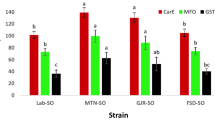Abstract
The augmented rates of pest infestation in stored grains have forced humans to rely on pesticide application in stored food grains even in developed countries. The greater incidence and alarming rate of pesticide resistance and safety concerns about their use in the food industry also contribute to ill-being of grain consumers and environment, thereby alluring constructive attempts to reduce the levels of agrochemical use. The current research elucidated the synergistic role of Hypericum japonicum (a medicinal plant) and pyrethroid deltamethrin in controlling the most common storage pest rice weevil, Sitophilus oryzae even at low concentrations than recommended by FAO. The screening of pesticidal property of methanolic extract of H. japonicum, pyrethroid deltamethrin, and their combinatorial assay was evaluated by standard procedures under laboratory conditions and mortality was gauged after 24 h of exposure. The LC50 and LC90 concentrations of deltamethrin alone (0.725 mg/l and 3.577 mg/l respectively) and in combination with Hypericum methanolic extract (LC50 0.119 mg/l and LC90 1.27 mg/l respectively) were found to be potent. The study revealed that the supplementation of plant extract in the pest controlling formulation substantially reduced the effective individual LC90 concentration of the pesticide required for pest control. The plant extracts showed synergy towards deltamethrin with SF 6.09. This is the foremost report on the synergistic effect of H. japonicum with deltamethrin against rice weevil, which could serve as an effective and more safer storage pest control method against the indiscriminate pesticide use and abuse.



Similar content being viewed by others
References
Abbott W (1925) A method of computing the effectiveness of an insecticide. J Econ Entomol 18:265–267
Agarwal R, Singh K, Sirvastava P, Varma B (1979) Assessment of storage losses in wheat and different refractions in periodic arrivals in mandis of Haryana. Bull Grain Technol 17:202–204
Ali A, Ahmad F, Biondi A, Wang Y, Desneux N (2012) Potential for using Datura alba leaf extracts against two major stored grain pests, the khapra beetle Trogoderma granarium and the rice weevil Sitophillus oryzae. J Pest Sci 85:359–366
Amelia-Yap ZH, Chen CD, Sofian-Azirun M, Low VL (2018) Pyrethroid resistance in the dengue vector Aedes aegypti in Southeast Asia: present situation and prospects for management. Parasites Vectors 11:332. https://doi.org/10.1186/s13071-018-2899-0
Anoopkumar A, Puthur S, Rebello S, Aneesh EM (2017) Screening of a few traditionally used medicinal plants for their larvicidal efficacy against Aedes aegypti Linn (Diptera: Culicidae), a dengue fever vector. SOJ Microbiol Infect Dis 5(4):1–5
Batta Y (2004) Control of rice weevil (Sitophilus oryzae L., Coleoptera: Curculionidae) with various formulations of Metarhizium anisopliae. Crop Prot 23:103–108
Bekele J, Asmare K, Abebe G, Ayelet G, Gelaye E (2010) Evaluation of deltamethrin applications in the control of tsetse and trypanosomosis in the southern rift valley areas of Ethiopia. Vet Parasitol 168:177–184
Belloa G, Padina S, Lastrab C, Fabrizio M (2000) Laboratory evaluation of chemical biological control of rice weevil (Sitophilus oryzae L.) in store grain. J Stored Prod Res 37:77–84
Cengiz EI, Bayar AS, Kizmaz V (2016) The protective effect of vitamin E against changes in fatty acid composition of phospholipid subclasses in gill tissue of Oreochromis niloticus exposed to deltamethrin. Chemosphere 147:138–143
de Andrade Dutra K, de Oliveira JV, Navarro DMdAF, Santos JPO (2016) Control of Callosobruchus maculatus (FABR.) (Coleoptera: Chrysomelidae: Bruchinae) in Vigna unguiculata (L.) WALP. with essential oils from four Citrus spp. plants. J Stored Prod Res 68:25–32
Haddi K, Valbon WR, Viteri Jumbo LO, de Oliveira LO, Guedes RNC, Oliveira EE (2018) Diversity and convergence of mechanisms involved in pyrethroid resistance in the stored grain weevils, Sitophilus spp. Sci Rep 8:16361. https://doi.org/10.1038/s41598-018-34513-5
Herrera JM, Goñi ML, Gañan NA, Zygadlo JA (2017) An insecticide formulation of terpene ketones against Sitophilus zeamais and its incorporation into low density polyethylene films. Crop Prot 98:33–39
Hong K-J, Lee W, Park Y-J, Yang J-O (2018) First confirmation of the distribution of rice weevil, Sitophilus oryzae, in South Korea. J Asia Pac Biodivers 11:69–75. https://doi.org/10.1016/j.japb.2017.12.005
Hosni K, Msaaˆda K, Taârit MB, Marzouk B (2017) Fatty acid composition and tocopherol content in four Tunisian Hypericum species: Hypericum perforatum, Hypericum tomentosum, Hypericum perfoliatum and Hypericum ericoides Ssp. Roberti. Arab J Chem 10:S2736–S2741
Huignard J, Glitho IA, Monge J-P, Regnault-Roger C (2011) Insectes ravageurs des graines de légumineuses: Biologie des Bruchinae et lutte raisonnée en Afrique. Editions Quae, Versailles
Kalyanasundaram M, Das P (1985) Larvicidal and synergistic activity of plant extracts for mosquito control. Indian J Med Res 82:19–23
Kamruzzaman M, Shahjahan M, Mollah M (2005) Laboratory evaluation of plant extracts as antifeedant against the lesser mealworm, Alphitobius diaperinus and rice weevil, Sitophilus oryzae. Pak J Sci Ind Res 48:252
Kuganathan N, Saminathan S, Muttukrishna S (2008) Toxicity of Datura alba leaf extract to aphids and ants internet. J Toxicol 5:1559–3916
Kumar J, Parmar BS (1996) Physicochemical and chemical variation in neem oils and some bioactivity leads against Spodoptera litura F. J Agric Food Chem 44:2137–2143
Li J, Jiang B, Liu X, Zhang J, Chen X, Bi K (2007) Simultaneous determination of five bioactive flavonoids in Hypericum japonicum Thunb by high-performance liquid chromatography. Asian J Trad Med 2:75–81
Liu ZL, Goh SH, Ho SH (2007) Screening of Chinese medicinal herbs for bioactivity against Sitophilus zeamais Motschulsky and Tribolium castaneum (Herbst). J Stored Prod Res 43:290–296
Maazoun AM, Hlel TB, Hamdi SH, Belhadj F, Jemâa JMB, Marzouki MN (2017) Screening for insecticidal potential and acetylcholinesterase activity inhibition of Urginea maritima bulbs extract for the control of Sitophilus oryzae (L.). J Asia Pac Entomol 20:752–760
Malik MF (2005) Bionomic field studies and integrated pest management of thrips with species innovation through agro-ecosystem of onion (Allium cepa) in Balochistan, Pakistan. University of Balochistan, Quetta
Mavundza E, Maharaj R, Finnie J, Kabera G, Van Staden J (2011) An ethnobotanical survey of mosquito repellent plants in uMkhanyakude district, KwaZulu-Natal province, South Africa. J Ethnopharmacol 137:1516–1520
Mishra BB, Tripathi S, Tripathi C (2013) Bioactivity of two plant derived essential oils against the rice weevils Sitophilus oryzae (L.) (Coleoptera: Curculionidae). Proc Natl Acad Sci India Sect B Biol Sci 83:171–175
Mohan L, Sharma P, Srivastava C (2007) Comparative efficacy of Solanum xanthocarpum extracts alone and in combination with a synthetic pyrethroid, cypermethrin, against malaria vector Anopheles stephensi. Southeast Asian J Trop Med Public Health 38:256
Morales-Rodriguez A, Peck DC (2009) Synergies between biological and neonicotinoid insecticides for the curative control of the white grubs Amphimallon majale and Popillia japonica. Biol Control 51:169–180
Muroi H, Kubo I (1993) Combination effects of antibacterial compounds in green tea flavor against Streptococcus mutans. J Agric Food Chem 41:1102–1105
Nenaah G (2011) Individual and synergistic toxicity of solanaceous glycoalkaloids against two coleopteran stored-product insects. J Pest Sci 84:77–86
Pascual-Villalobos M, Robledo A (1998) Screening for anti-insect activity in Mediterranean plants. Ind Crops Prod 8:183–194
Peng J, Fan G, Wu Y (2006) Preparative separation and isolation of three flavonoids and three phloroglucinol derivatives from Hypericum japonicum Thumb. using high-speed countercurrent chromatography by stepwise increasing the flow rate of the mobile phase. J Liq Chromatogr Relat Technol 29:1619–1632
Puthur S, Anoopkumar A, Rebello S, Aneesh EM (2018) Hypericum japonicum: a double-headed sword to combat vector control and cancer. Appl Biochem Biotechnol 186:1–11
Ribeiro B, Guedes R, Oliveira E, Santos J (2003) Insecticide resistance and synergism in Brazilian populations of Sitophilus zeamais (Coleoptera: Curculionidae). J Stored Prod Res 39:21–31
Saad MM, Abou-Taleb HK, Abdelgaleil SA (2018) Insecticidal activities of monoterpenes and phenylpropenes against Sitophilus oryzae and their inhibitory effects on acetylcholinesterase and adenosine triphosphatases. Appl Entomol Zool 53:173–181
Salerno G, Colazza S, Conti E (2002) Sub-lethal effects of deltamethrin on walking behaviour and response to host kairomone of the egg parasitoid Trissolcus basalis. Pest Manag Sci 58:663–668
Samaga PV, Rai VR (2013) Evaluation of pharmacological properties and phenolic profile of Hypericum japonicum Thunb. from Western Ghats of India. J Pharm Res 7:626–632
Scott I et al (2002) Insecticidal activity of Piper tuberculatum Jacq. extracts: synergistic interaction of piperamides. Agric For Entomol 4:137–144
Sreedev P (2016) A comparative analysis of larvicidal efficacy of Piper longum and Ruta graveolens against Aedes aegypti a dengue virus vector. Asia Pac J Res I(XXXVI):200–205
Srivastava C, Subramanian S (2016) Storage insect pests and their damage symptoms: an overview. Indian J Entomol 78:53–58
Sun Y-P, Johnson E (1960) Analysis of joint action of insecticides against house flies. J Econ Entomol 53:887–892
Suresh U et al (2017) Suaeda maritima-based herbal coils and green nanoparticles as potential biopesticides against the dengue vector Aedes aegypti and the tobacco cutworm Spodoptera litura. Physiol Mol Plant Pathol 101:225–235
Tennyson S, Ravindran KJ, Arivoli S (2012) Screening of twenty five plant extracts for larvicidal activity against Culex quinquefasciatus Say (Diptera: Culicidae). Asian Pac J Trop Biomed 2:S1130–S1134
Thangam TS, Kathiresan K (1991) Mosquito larvicidal activity of marine plant extracts with synthetic insecticides. Bot Mar 34:537–540
Vélez M, Barbosa W, Quintero J, Chediak M, Guedes R (2017) Deltamethrin-and spinosad-mediated survival, activity and avoidance of the grain weevils Sitophilus granarius and S. zeamais. J Stored Prod Res 74:56–65
Acknowledgements
We thank Principal, St. Joseph’s College for the laboratory facilities provided.
Funding
We are greatly thankful to the University Grants Commission, New Delhi for providing funds under the UGC Research Award - F30-6/20-16(SA-II).
Author information
Authors and Affiliations
Contributions
SP and EMA designed experiments and analyzed data. SP conducted experiments. ANA and SR did the statistical analysis. All authors contributed to writing the paper.
Corresponding author
Ethics declarations
Conflict of interest
The Authors SP, ANA, SR, and EMA declare that they have no conflict of interest.
Ethical approval
This article does not contain any studies with human participants or animals performed by any of the authors.
Additional information
Publisher's Note
Springer Nature remains neutral with regard to jurisdictional claims in published maps and institutional affiliations.
Rights and permissions
About this article
Cite this article
Puthur, S., Anoopkumar, A.N., Rebello, S. et al. Synergistic control of storage pest rice weevil using Hypericum japonicum and deltamethrin combinations: a key to combat pesticide resistance. Environmental Sustainability 2, 411–417 (2019). https://doi.org/10.1007/s42398-019-00086-w
Received:
Revised:
Accepted:
Published:
Issue Date:
DOI: https://doi.org/10.1007/s42398-019-00086-w




